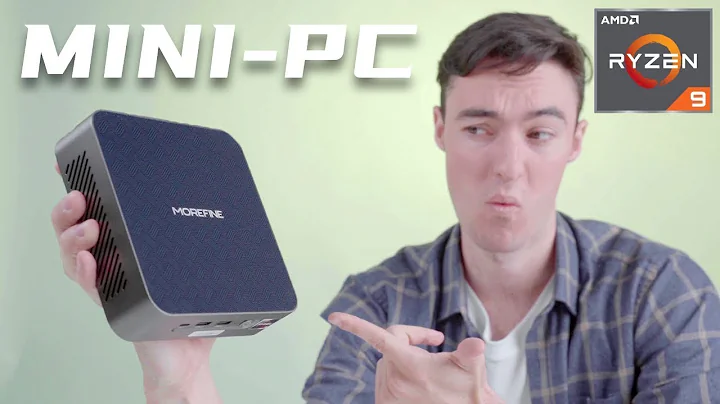Revolutionizing Mid-Range FPGAs: Introducing Arria-10 FPGAs & SoCs
Table of Contents
- Introduction
- Understanding the Mid-Range FPGA Category
- The Need for Reinventing Mid-Range FPGAs
- Increasing Demand for Information
- Power and Cost Optimization
- The Breakthrough Capabilities of Aria-10 FPGAs and SoCs
- Higher Performance than Previous High-End FPGAs
- Lower Power Than Mid-Range FPGAs
- Maintaining the Same Footprint
- The Reinvention Process of Mid-Range FPGAs and SoCs
- Selection of 20 Nanometer SoC Process
- Integration of High-Performance Fabric Architecture
- Providing Unprecedented Performance for Mid-Range FPGAs
- Meeting the Bandwidth Requirements
- Integration of High-Speed Serial Transceivers
- Connecting Serial Memory Interfaces
- Support for External Memory Interfaces
- Considerations on Power Consumption
- Integration of ARM Processor and Hard Memory Controllers
- Innovative Power Reduction Technologies
- Software Support and Development Tools
- Applications Driving the Need for Reinvention
- Telecommunications and Wireless Infrastructure
- Storage Market and Cloud Computing
- Broadcast Television and 4K Ultra High Definition
- Military Applications and Signal Bandwidth
- The Advantages of Aria-10 FPGAs and SoCs
- Conclusion
Reinventing the Mid-Range FPGA Category: Aria-10 FPGAs and SoCs
🔥
Introduction
In today's rapidly evolving technological landscape, the demand for more information has grown exponentially. From computers to smartphones, televisions to military equipment, the need for increased data delivery has caused an explosion of data in both wired and wireless telecommunications infrastructure. To meet this challenge, technology leaders like Altera have developed breakthrough solutions, such as Aria-10 FPGAs and SoCs, to reinvent the mid-range FPGA category. In this article, we will explore the meaning behind this reinvention and the capabilities that set Aria-10 FPGAs and SoCs apart.
Understanding the Mid-Range FPGA Category
Before diving into the reinvention of mid-range FPGAs, it is important to grasp the concept of this category. Mid-range FPGAs typically offer a balance between performance, power consumption, and cost. They cater to applications that require moderate computing capabilities and fall between high-end FPGAs with extensive functionalities and low-end FPGAs with limited capabilities. Traditionally, mid-range FPGAs have been known for their lower power consumption compared to high-end FPGAs.
The Need for Reinventing Mid-Range FPGAs
- Increasing Demand for Information
In today's digital age, there is a growing demand for more information across various devices and industries. From voice and data to streaming video, the pace at which information is being delivered has escalated. This surge in data has put immense pressure on the wireline and wireless infrastructure of the telecommunications industry.
- Power and Cost Optimization
Alongside the data explosion, application requirements have also evolved. Power and cost optimization have become key considerations for communication infrastructure providers. They need to deliver more information rapidly while staying within their budgets and maintaining the same infrastructure footprint. This necessitates a fundamental rethinking of mid-range FPGA solutions.
The Breakthrough Capabilities of Aria-10 FPGAs and SoCs
Aria-10 FPGAs and SoCs introduced by Altera provide breakthrough capabilities that were not possible in the previous mid-range FPGA category. Let's explore the remarkable advantages Aria-10 FPGAs and SoCs offer.
- Higher Performance than Previous High-End FPGAs
One of the defining features of Aria-10 FPGAs and SoCs is their higher performance compared to previous generation high-end FPGAs. This enhanced performance enables them to handle complex applications and deliver superior results. Aria-10 FPGAs and SoCs achieve a 15% performance increase compared to the previous generation of high-end FPGAs.
- Lower Power Than Mid-Range FPGAs
While maintaining their impressive performance, Aria-10 FPGAs and SoCs also excel in power optimization. They Consume lower power than other mid-range FPGAs available in the market. This breakthrough ensures that system-level designs can achieve high performance without compromising energy efficiency.
- Maintaining the Same Footprint
Another advantage of Aria-10 FPGAs and SoCs is their ability to maintain the same footprint as existing infrastructure. This means that customers can seamlessly integrate Aria-10 FPGAs and SoCs into their current systems without extensive redesign or alterations. It offers a cost-effective solution while simultaneously providing improved performance and lower power consumption.
The Reinvention Process of Mid-Range FPGAs and SoCs
To achieve the remarkable capabilities of Aria-10 FPGAs and SoCs, a fundamental reinvention of the mid-range FPGA category was required. Let's delve into the process that led to this significant innovation.
- Selection of 20 Nanometer SoC Process
To lay the foundation for increased performance and power optimization, Altera selected the advanced 20 nanometer SoC process offered by their fabrication partner, TSMC. This process allows for greater integration of components and more efficient power management.
- Integration of High-Performance Fabric Architecture
In addition to the advanced process technology, Aria-10 FPGAs and SoCs feature a high-performance fabric architecture. This architecture enhances the efficiency and performance of these devices, enabling them to surpass the performance of previous high-end FPGAs.
- Providing Unprecedented Performance for Mid-Range FPGAs
The combination of the 20 nanometer process and high-performance fabric architecture allows Aria-10 FPGAs and SoCs to deliver a Record-breaking 15% increase in performance compared to previous high-end FPGAs. This level of performance had not been experienced in the mid-range FPGA category before.
Meeting the Bandwidth Requirements
In addition to performance and power optimization, Aria-10 FPGAs and SoCs address the growing need for increased bandwidth in various applications. Let's explore the features that enable these devices to meet bandwidth requirements.
- Integration of High-Speed Serial Transceivers
Aria-10 FPGAs and SoCs integrate 96 high-speed serial transceivers, capable of supporting data rates of up to 28 gigabits per Second. This integration enables these devices to deliver a staggering bandwidth of over 3.6 terabits per second. The high-speed transceivers also support the connection of multiple serial memory interfaces, offering a bandwidth of 1 terabit per second for hybrid memory cubes.
- Connecting Serial Memory Interfaces
With the capability to connect up to 16 serial memory interfaces or four links at data rates up to 15 gigabits per second, Aria-10 FPGAs and SoCs provide the necessary bandwidth required for demanding applications. This allows for seamless integration with memory interfaces like DDR4 SDRAM, supporting up to four by 72 DDR4 interfaces at data rates of 2.66 gigabits per second.
- Support for External Memory Interfaces
Furthermore, Aria-10 FPGAs and SoCs enable the direct connection of high-performance external memory interfaces. Applications that demand high memory capacity can leverage the support for external interfaces, such as DDR4 SDRAM. This helps achieve increased efficiency and performance in memory-intensive operations.
Considerations on Power Consumption
While delivering exceptional performance and meeting bandwidth requirements, Aria-10 FPGAs and SoCs also prioritize power consumption optimization. Let's explore the measures taken to reduce power consumption.
- Integration of ARM Processor and Hard Memory Controllers
To maximize the integration capabilities, Aria-10 FPGAs and SoCs incorporate a dual-core ARM processor. This integration enables the consolidation of important logic into a single system-level chip, minimizing chip count, power consumption, and cost. The inclusion of hard memory controllers further enhances the memory-centric functionalities of these devices.
- Innovative Power Reduction Technologies
To complement the power advantages gained from the selection of the 20 nanometer process and integrated hard IP, Aria-10 FPGAs and SoCs offer a comprehensive set of power reduction technologies. These technologies contribute to up to 40% lower power consumption compared to previous generation mid-range FPGAs.
Software Support and Development Tools
Altera, known for its software leadership, has developed robust tools that enhance the productivity of designers working with Aria-10 FPGAs and SoCs. The Quartus II software design suite, including Qsys system integration tool, OpenCL, C-based design entry tool, and DSP Builder for model-based DSP design, ensures a seamless and efficient design process. With Altera's software support, designers can optimize their FPGA designs, reducing time and effort significantly.
Applications Driving the Need for Reinvention
The need for reinventing mid-range FPGAs has been primarily driven by specific applications with demanding requirements. Let's explore some of these applications and their contributions to the need for advanced solutions like Aria-10 FPGAs and SoCs.
- Telecommunications and Wireless Infrastructure
With the increasing deployment of wireless infrastructure, demands for higher bandwidth and network capacity have surged. Aria-10 FPGAs and SoCs address these demands by offering 15% higher performance, enabling telecom providers to meet the requirements of ever-growing data transmission.
- Storage Market and Cloud Computing
Cloud computing, a rapidly growing trend in the storage market, has put tremendous pressure on flash-assisted storage systems. The need for greater bandwidth and storage capacity has made Aria-10 FPGAs and SoCs indispensable in this domain.
- Broadcast Television and 4K Ultra High Definition
The transition to 4K ultra-high-definition broadcasting has increased the demand for higher system bandwidth. Aria-10 FPGAs and SoCs empower broadcast system designers to meet this demand with ease and efficiency, enhancing the viewing experience without compromising cost constraints.
- Military Applications and Signal Bandwidth
The military sector relies heavily on secure communications and radar applications, which require high signal bandwidth. Aria-10 FPGAs and SoCs offer the necessary capabilities to support these applications, even in mobile and challenging environments.
The Advantages of Aria-10 FPGAs and SoCs
In summary, Aria-10 FPGAs and SoCs provide a revolutionary approach to the mid-range FPGA category. Their breakthrough capabilities, including higher performance than previous high-end FPGAs, lower power consumption than mid-range FPGAs, and integration of advanced features, make them an optimal choice for a wide range of applications. With Altera's software support and development tools, designers can unleash the full potential of Aria-10 FPGAs and SoCs, making them a powerful solution in the ever-evolving technological landscape.
Conclusion
The reinvention of the mid-range FPGA category through Aria-10 FPGAs and SoCs marks a significant milestone in the semiconductor industry. The ability to deliver high performance, lower power consumption, and maintain the same footprint addresses the growing demands of various applications. As technology continues to evolve, Altera remains at the forefront, providing innovative solutions to meet the ever-increasing data and performance requirements of the digital era.
Highlights:
- Aria-10 FPGAs and SoCs reinvent the mid-range FPGA category with breakthrough capabilities.
- These devices offer higher performance than previous high-end FPGAs while consuming lower power than mid-range FPGAs.
- Aria-10 FPGAs and SoCs integrate advanced features, such as high-speed serial transceivers and external memory interface support.
- Power reduction technologies result in up to 40% lower power consumption compared to the previous generation.
- Altera's software support and development tools enhance designer productivity and optimize FPGA designs.
Frequently Asked Questions (FAQ):
Q: What is the mid-range FPGA category?
A: Mid-range FPGAs strike a balance between performance, power consumption, and cost, catering to applications with moderate computing needs.
Q: How do Aria-10 FPGAs and SoCs reinvent the mid-range FPGA category?
A: Aria-10 FPGAs and SoCs offer higher performance than previous high-end FPGAs, lower power consumption than mid-range FPGAs, and integration of advanced features, making them a groundbreaking solution.
Q: What are the advantages of Aria-10 FPGAs and SoCs?
A: Aria-10 FPGAs and SoCs provide unprecedented performance, lower power consumption, and maintain the same footprint. They also support high-speed serial transceivers and external memory interfaces.
Q: Which industries benefit from Aria-10 FPGAs and SoCs?
A: Aria-10 FPGAs and SoCs are particularly beneficial for the telecommunications, storage, broadcast television, and military sectors, addressing their specific bandwidth and performance requirements.
 WHY YOU SHOULD CHOOSE TOOLIFY
WHY YOU SHOULD CHOOSE TOOLIFY

























